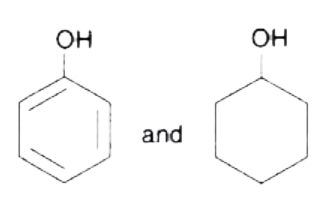Name the type of isomerism shown by the following pair of compounds :
[PtCl2(NH3)4Br2and[PtBr2(NH3)4]Cl2
Give a chemical test to distinguish between the given pair of isomers.
To solve the problem, we need to identify the type of isomerism shown by the compounds (PtCl2(NH3)4Br2) and (PtBr2(NH3)4)Cl2. We also need to provide a chemical test to distinguish between these isomers.
1. Identify the Compounds:
- The first compound is (PtCl2(NH3)4Br2).
- The second compound is (PtBr2(NH3)4)Cl2.
2. Analyze the Structure:
- In the first compound, there are two chloride ions (Cl) and two bromide ions (Br) coordinated to the platinum (Pt) center.
- In the second compound, there are two bromide ions coordinated to platinum and two chloride ions outside the coordination sphere.
3. Determine the Type of Isomerism:
- The difference in the position of the ions (whether they are inside or outside the coordination sphere) indicates that these compounds are ionization isomers.
- Ionization isomerism occurs when two compounds have the same formula but differ in the arrangement of ions, leading to different ions being released in solution.
4. Chemical Test to Distinguish the Isomers:
- To distinguish between the two isomers, we can perform a chemical test using silver nitrate (AgNO3).
- When AgNO3 is added to the first compound (PtCl2(NH3)4Br2), it will react with the free bromide ions (Br-) to form a yellow precipitate of silver bromide (AgBr).
- Conversely, when AgNO3 is added to the second compound (PtBr2(NH3)4)Cl2, it will react with the free chloride ions (Cl-) to form a white precipitate of silver chloride (AgCl).
Final Answer:
- The type of isomerism shown by the compounds is ionization isomerism.
- The chemical test to distinguish between the isomers is the addition of AgNO3, which produces a yellow precipitate of AgBr for the first compound and a white precipitate of AgCl for the second compound.
- The first compound is (PtCl2(NH3)4Br2).
- The second compound is (PtBr2(NH3)4)Cl2.
- In the first compound, there are two chloride ions (Cl) and two bromide ions (Br) coordinated to the platinum (Pt) center.
- In the second compound, there are two bromide ions coordinated to platinum and two chloride ions outside the coordination sphere.
- The difference in the position of the ions (whether they are inside or outside the coordination sphere) indicates that these compounds are ionization isomers.
- Ionization isomerism occurs when two compounds have the same formula but differ in the arrangement of ions, leading to different ions being released in solution.
- To distinguish between the two isomers, we can perform a chemical test using silver nitrate (AgNO3).
- When AgNO3 is added to the first compound (PtCl2(NH3)4Br2), it will react with the free bromide ions (Br-) to form a yellow precipitate of silver bromide (AgBr).
- Conversely, when AgNO3 is added to the second compound (PtBr2(NH3)4)Cl2, it will react with the free chloride ions (Cl-) to form a white precipitate of silver chloride (AgCl).
- The type of isomerism shown by the compounds is ionization isomerism.
- The chemical test to distinguish between the isomers is the addition of AgNO3, which produces a yellow precipitate of AgBr for the first compound and a white precipitate of AgCl for the second compound.
Topper's Solved these Questions
- BOOK - ICSECHAPTER - COORDINATION COMPOUNDS EXERCISE - ISC EXAMINATION QUESTION (PART - I OBJECTIVE QUESTIONS)4videos
COORDINATION COMPOUNDS
- BOOK - ICSECHAPTER - CHEMISTRY-2020 EXERCISE - Question (Answer the following question)4videos
CHEMISTRY-2020
- BOOK - ICSECHAPTER - d- AND- f- BLOCK ELEMENTSEXERCISE - ISC EXAMINATION QUESTIONS (PART-II)(DESCRIPTIVE QUESTIONS)15videos
d- AND- f- BLOCK ELEMENTS
Similar Questions
Name the types of isomerism shown by the following pairs of compound [CoCl(H2O)(NH3)4]Cl2and[CoCl2(NH3)4]Cl.H2O
View SolutionGive a chemical test to distinguish between the following pairs of compounds:
 View Solution
View SolutionName the types of isomerism shown by the following pairs of compounds :
[Cu(NH3)4][Pt(Cl)4]and[Pt(NH3)4][CuCl4]View SolutionName the types of isomerism shown by the following pairs of compound [Pt(NH3)4][PtCl6]and[Pt(NH3)4Cl2][PtCl4]
View SolutionWhat type of isomerism is exhibited by the following pairs of compounds :
[PtCl2(NH3)4]Br2and[PtBr2(NH3)4]Cl2View SolutionName the types of isomerism shown by the following pairs of compounds :
[Cu(NH3)4][Pt(Cl4)]and[Pt(NH3)4][CuCl4]View SolutionName the types of isomerism shown by the following pairs of compounds :
[Co(Pn)2Cl2]+and[Co(tn)2Cl2]+View SolutionGive a chemical test to distinguish between the following gases
NH3 and HCIView SolutionGive a chemical test to distinguish between the following gases
NH3 and SO2View SolutionName the type of isomerism exhibited by the following pairs of compounds :
(C2H5)NHandCH3−NH−C3H7View Solution
